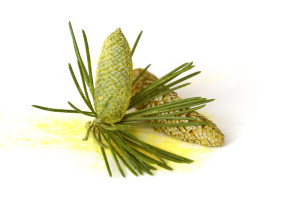 Nasal allergy (allergic rhinitis) occurs when the nasal lining is irritated or inflamed. It is often accompanied by asthma, since the lining of the nose continues into the lung; and eczema. Like asthma, it may be acute or chronic. Usually, sneezing,congestion, itching, and clear/watery nasal discharge with or without post-nasal drip occur. Associated symptoms/complications include headache, earache, red/itchy eyes, fatigue/drowsiness and inability to smell. Children, especially, may demonstrate “allergic shiners”—dark circles around eyes; and a “nasal crease”—a horizontal nose crease from rubbing the nose. Although also caused by other factors, nasal septum deviation and even perforation may occur in chronic, severe cases.
Nasal allergy (allergic rhinitis) occurs when the nasal lining is irritated or inflamed. It is often accompanied by asthma, since the lining of the nose continues into the lung; and eczema. Like asthma, it may be acute or chronic. Usually, sneezing,congestion, itching, and clear/watery nasal discharge with or without post-nasal drip occur. Associated symptoms/complications include headache, earache, red/itchy eyes, fatigue/drowsiness and inability to smell. Children, especially, may demonstrate “allergic shiners”—dark circles around eyes; and a “nasal crease”—a horizontal nose crease from rubbing the nose. Although also caused by other factors, nasal septum deviation and even perforation may occur in chronic, severe cases.
Typical allergic rhinitis triggers are similar to allergic asthma’s: pollen, mold, dust mites, animals, and food. When conditions warrant, skin or blood testing can identify the allergy’s source. If an obstruction (such as a polyp, cyst, stricture, or tumor) is suspected, MRI/CT and possibly endoscopy (camera study) may be indicated.
Chronically inflamed and congested sinus tissues make a hospitable environment for viruses and bacteria to grow, potentially leading to acute, chronic or recurrent sinus infections (or sinusitus). Certain autoimmune diseases (hypothyroidism, sarcoidosis) can cause a non-allergic form of rhinitis. Those with autonomic/vagal nerve dysfunction may have a vasomotor rhinitis that occurs immediately after eating (gustatory rhinitis).
Conventional (Western) Treatment consists of 3 major strategies: (1) allergen avoidance; (2) medication including antihistamines, decongestants, mast cell stabilizers like cromalyn, leukotriene inhibitors like Singular, nasal steroid like Flonase for allergies, and antibiotics for infections; and (3) possibly immunotherapy (“allergy shots”) to desensitize the system to the offending agents. Even conventional therapists currently add Neti Pot, the Ayurvedic tradition of daily or regular saline nasal wash, to help improve allergic rhinitis and prevent sinus infections (when used properly with filtered water).[1]
In Traditional Chinese Medicine (TCM), allergic rhinitis is considered a sign of significant derangement of the body’s overall “balance” (homeostasis). Indeed, recent Western studies show as strong correlation between allergic rhiniti s and ADHD in children.[6] Rhinitis can indicate a “Wei Qi” (defensive energy /immune system) deficiency, “Internal Cold”, “Spleen Yang deficiency” (“Spleen System failing to transport Fluids”, which then accumulate in the upper respiratory system’s mucous membranes), and/or “Lung System excess or deficiency”. All allergic rhinitis sufferers will likely to benefit from “moving/draining Damp/Phlegm”. However, because of the multiple causes, different people require different treatments (at different times) to address allergic rhinitis. For example, those with severe fatigue accompanying the symptoms requ
s and ADHD in children.[6] Rhinitis can indicate a “Wei Qi” (defensive energy /immune system) deficiency, “Internal Cold”, “Spleen Yang deficiency” (“Spleen System failing to transport Fluids”, which then accumulate in the upper respiratory system’s mucous membranes), and/or “Lung System excess or deficiency”. All allergic rhinitis sufferers will likely to benefit from “moving/draining Damp/Phlegm”. However, because of the multiple causes, different people require different treatments (at different times) to address allergic rhinitis. For example, those with severe fatigue accompanying the symptoms requ
ire “Wei Qi tonification”; those with headaches often benefit from “Spleen Yang tonification to mobilize Fluids”. Both TCM and Ayurveda link refined carbohydrates; glutinous, oily or fried foods; and cold and unrefined dairy products to “Phlegm” production.
As a complex problem, multiple treatment modalities are used. Most dramatically, Allergy Relief Acupuncture may actually eliminate or attenuate allergic responses, and significantly reduce allergy symptoms. Acupuncture (there is even a classical treatment called “sinus deep drainage”) can effectively initiate relief. Chinese Herbal Medicine goes further to address the underlying problem. Since allergic rhinitis is considered a “deeper” problem in TCM, Chinese herbs require compliance usually for 6 to 18 months to achieve the longest lasting effects. However, to speed relief, Dr. Villanova adds Comprehensive Sinus Therapy to excellent effect.[2,3]
Learn more about Allergic Rhinitis
Learn more about Sinus Infection
X
These brief overviews of conditions represent distillations of basic and current medical reviews from the following sources:
[1] Conventional Medical Sources“Harrison’s Principles of Internal Medicine: Volumes 1 and 2, 18th Edition”. Dan Longo Anthony Fauci, Dennis Kasper, Stephen Hauser, J. Jameson, Joseph Loscalzo. McGraw-Hill Professional; (July, 2011)
Medscape eMedicine Physician’s online resource. Various review articles:
Allergic and Environmental Asthma: an Overview of Asthma
William F Kelly III, MD Associate Professor of Medicine, Uniformed Services University of the Health Sciences; Staff physician, Division of Pulmonary/Critical Care Medicine, Department of Medicine, Walter Reed National Military Medical Center
Allergic Rhinitis
Javed Sheikh, MD Assistant Professor of Medicine, Harvard Medical School; Clinical Director, Division of Allergy and Inflammation, Clinical Director, Center for Eosinophilic Disorders, Beth Israel Deaconess Medical Center
Food Allergies
Scott H Sicherer, MD Professor of Pediatrics, Jaffe Food Allergy Institute, Mount Sinai School of Medicine of New York University
Atopic Dermatitis
Brian S Kim, MD Clinical Instructor, Department of Dermatology, Hospital of the University of Pennsylvania, Perelman School of Medicine, University of Pennsylvania
Seborrheic Dermatitis
Samuel T Selden, MD Assistant Professor Department of Dermatology Eastern Virginia Medical School; Consulting Staff, Chesapeake General Hospital; Private Practice
Psoriasis
Jeffrey Meffert, MD Assistant Clinical Professor of Dermatology, University of Texas School of Medicine at San Antonio
Urticaria
M Scott Linscott, MD, FACEP Adjunct Professor of Surgery (Clinical), Division of Emergency Medicine, University of Utah School of Medicine
Cholinergic Urticaria
Robert A Schwartz, MD, MPH Professor and Head, Dermatology, Professor of Pathology, Pediatrics, Medicine, and Preventive Medicine and Community Health, University of Medicine and Dentistry of New Jersey-New Jersey Medical School
- “Acupuncture Energetics: A Clinical Approach for Physicians”. Joseph M. Helms. Medical Acupuncture Publishers; 1st Edition. (1995)
- “Foundations of Chinese Medicine: A Comprehensive Text for Acupuncturists and Herbalists”. Giovanni Maciocia. Churchill Livingstone; 2 Edition (July, 2005).
- “Diagnosis in Chinese Medicine: A Comprehensive Guide”. Giovanni Maciocia. Churchill Livingstone; 1st Edition (January, 2004).
4. “Chinese Scalp Acupuncture”. Jason Ji-shun Hao, Linda Ling-zhi Hao and Honora Lee Wolfe. Blue Poppy Press; 1st Edition. (November, 2011)
5. Ege MJ, Mayer M, Normand AC, Genuneit J, Cookson WO, Braun-Fahrländer C, et al. Exposure to environmental microorganisms and childhood asthma. N Engl J Med. Feb 24 2011;364(8):701-9. [Medline]
6. Tsai JD, Chang SN, Mou CH, Sung FC, Lue KH. Association between atopic diseases and attention-deficit/hyperactivity disorder in childhood: a population-based case-control study. Ann Epidemiol. Apr 2013;23(4):185-8. [Medline].
7. JPEN J Parenter Enteral Nutr. 2012 Jan;36(1 Suppl):68S-75S. doi: 10.1177/0148607111426276
8. Rubio-Tapia A, Kyle RA, Kaplan EL, et al. Increased prevalence and mortality in undiagnosed celiac disease. Gastroenterology.2009;137:88-93.
9. Thompson T. Gluten contamination of commercial oat products in the United States. N Engl J Med. 2004;351:2021-2022.
10. Häuser W, Janke KH, Klump B, Gregor M, Hinz A. Anxiety and depression in adult patients with celiac disease on the gluten free diet. World J Gastroenterol. 2010;16:2780-2787.
11. Am. J. Epidemiol. (2013)178 (12):1721–1730doi:10.1093/aje/kwt234
12. Addolorato G, Di Guida D, De Rossi G, et al. Regional cerebral hypoperfusion in patients with celiac disease. Am J Med. 2004;116:312-317.
13. Sapone A, Lammers KM, Casolaro V, et al. Divergence of gut permeability and mucosal immune gene expression in two glutenassociated conditions: celiac disease and gluten sensitivity. BMC Med. 2011;9:23.
14. Biesiekierski JR, Newnham ED, Irving PM, et al. Gluten causes gastrointestinal symptoms in subjects without celiac disease: a double-blind randomized placebo-controlled trial. Am J Gastroenterol. 2011;106:508-514.
15. Yamini D, Pimentel M. Irritable bowel syndrome and small intestinal bacterial overgrowth. J Clin Gastroenterol. 2010;44:672-675.
16. Wahnschaffe U, Schulzke J-D, Zeitz M, Ullrich R. Predictors of clinical response to gluten-free diet in patients diagnosed with diarrhea-predominant irritable bowel syndrome. Clin Gastroenterol Hepatol. 2007;5:844-850.
17. Hadjivassiliou M, Grunewald RA, Chattopadhyay AK, et al. Clinical, radiological, neurophysiological and neuropatholgical characteristics of gluten ataxia. Lancet. 1998;352:1582-1585.
18. Hadjivassiliou M, Boscolo S, Davies-Jones A, et al. The humoral response in the pathogenesis of gluten ataxia. Neurology. 2002;58:1221-1226.
19. Dieterich W, Ehnis T, Bauer M, et al. Identification of tissue transglutaminase as the autoantigen of celiac disease. Nat Med. 1997;7:797-801.
20. Korponay-Szabo IR, Halttunen T, Szalai Z, et al. In vivo targeting of intestinal and extraintestinal transglutaminase 2 by coeliac autoantibodies. Gut. 2004;53:641-648.
21. Hadjivassiliou M, Maki M, Sanders DS, et al. Autoantibody targeting of brain and intestinal transglutaminase in gluten ataxia. Neurology. 2006;66:373-377.
22. Tengah CP, Lock RJ, Unsworth DJ, Wills A. Multiple sclerosis and occult gluten sensitivity. Neurology. 2004;62:2326-2327.
23. Hadjivassiliou M, Sander DS, Grünewald RA. Multiple sclerosis and occult gluten sensitivity. Neurology. 2005;64:933-934.
24· Lever R, MacDonald C, Waugh P, Aitchison T. Randomised controlled trial of advice on an egg exclusion diet in young children with atopic eczema and sensitivity to eggs. Pediatr Allergy Immunol. Feb 1998;9(1):13-9. [Medline].
25. Branum AM, Lukacs SL. Food allergy among children in the United States. Pediatrics. Dec 2009;124(6):1549-55. [Medline].
26. Fleischer DM, Burks AW, Vickery BP, Scurlock AM, Wood RA, Jones SM, et al. Sublingual immunotherapy for peanut allergy: a randomized, double-blind, placebo-controlled multicenter trial. J Allergy Clin Immunol. Jan 2013;131(1):119-27.e1-7. [Medline]. [Full Text].
27. Hand L. Probiotics may protect infants from allergy, but not asthma. Medscape Medical News [serial online]. August 19, 2013;Accessed August 25, 2013. Available at http://www.medscape.com/viewarticle/809604.
28. Elazab N, Mendy A, Gasana J, Vieira ER, Quizon A, Forno E. Probiotic Administration in Early Life, Atopy, and Asthma: A Meta-analysis of Clinical Trials. Pediatrics. Aug 19 2013;[Medline].
29. O’Connel RA. SPECT brain imaging in psychiatric disorders: current clinical status. In: Grünwald F, Kasper S, Biersack HJ, Möller HJ, eds. Brain SPECT Imaging in Psychiatry. Berlin: de Gruyter; 1995:35-57.
30. Grasby PM, Bench C. Neuroimaging in mood disorders. Curr Opin Psychiatry. 1997;10:73-78.
